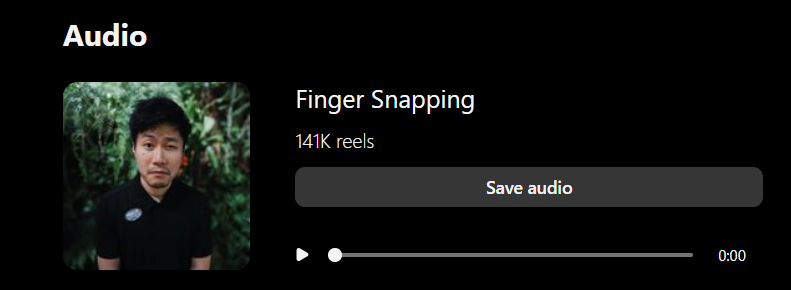If you’ve been wondering how to make your brand stand out with engaging short videos, you’re in the right place. In the first part of this series, we covered the basics of creating short-form videos—setting the foundation for content that not only grabs attention but also keeps viewers coming back for more. Now, we’re taking it up a notch.
In this post, we’ll dive into the practical steps of starting your content creation journey tailored specifically for the food and beverage industry. From finding your niche and planning ahead, we’ll walk you through the entire video production process—from finding inspiration and adapting trends to scripting, recording, and editing your videos the smart and simple way.
Ready to create short videos that engage and convert? Let’s get started.
How to Start with Content Creation?
Creating compelling short-form videos takes more than just spontaneous creativity. For food and beverage brands, finding your niche, understanding your audience, studying the competitors in your niche, and incorporating trends are essential first steps to ensure your videos hit the mark.
1. Find Your Content Niche
When a food brand begins its social media journey with short videos, the key is to find a niche that complements what the brand is selling while engaging a broader audience. The niche doesn’t have to be an exact match to the product but should be closely related to the brand’s values, target audience, and the lifestyle associated with the product.
This is how it looks as a step-by-step process:

Step 1: 🧭 Identify Your Brand’s Core Values & Unique Selling Points (USPs)
- How to do it: Begin by understanding what sets your brand apart. Is your product organic, locally sourced, or focused on health and wellness? These core values can guide you toward a niche.
- Example: If your brand sells organic snacks, your niche might focus on clean eating, sustainability, or quick, healthy snack ideas for busy parents.
Step 2: 🔍 Analyze Competitors
- How to do it: Study what your competitors are doing on social media. Look at the types of content they’re producing, which niches they’re focusing on, and what’s working for them. This analysis can reveal gaps in the market that your brand can fill or inspire new content ideas.
- Example: If a competitor’s “5-ingredient recipe” series is performing well, consider creating a similar series with your own unique twist.
Step 3: 🎯 Explore Your Target Audience’s Interests
- How to do it: Research what your target audience is already interested in. This could be through social media listening tools, customer surveys, or analyzing the content your audience engages with.
- Example: If your audience is interested in fitness and wellness, consider creating short videos that highlight healthy meal prep ideas using your products.
Step 4: 🧩 Look for Overlapping Themes
- How to do it: Find themes that overlap with your brand’s products and broader lifestyle trends. Your niche should align with these themes, plus offer a unique perspective or solution.
- Example: A brand selling artisanal cheeses could create content around gourmet home cooking, pairing ideas, or cheese and wine-tasting events.
Step 5: 🔗 Leverage Related Niches & Lifestyles
- How to do it: Consider niches and lifestyles that may not be directly about your product but are related and popular with your target audience. This approach can draw in a broader audience who might also be interested in your offerings.
- Example: A brand selling coffee could explore creating content like morning routines, productivity hacks, or even travel content featuring coffee culture around the world.
Step 6: 🛠️ Test & Adapt Content
- How to do it: Start by experimenting with different content types that relate to your potential niche. Monitor engagement metrics to see what resonates most with your audience.
- Example: If you’re unsure whether to focus on quick recipes or detailed cooking tutorials, try both and analyze which drives more engagement.
By starting with your brand’s values and exploring related themes and audience interests, you can find a niche that not only complements what you’re selling but also attracts a loyal and engaged following on social media. This strategy helps in creating content that feels authentic to your brand while expanding your reach.
2. Plan Ahead
When it comes to planning video content, one of the most crucial steps is to create a realistic plan that aligns with your capabilities and resources. It’s tempting to aim high, but overcommitting can lead to burnout and inconsistency, which can confuse your audience and weaken your brand presence.
Start by assessing your resources—consider the time, budget, and team you have available for content creation. Based on this, set a manageable frequency for posting that you can consistently maintain, whether that’s once a week or multiple times per day.
Next, build a content calendar that outlines your video topics, filming schedule, and posting dates. This calendar should be flexible enough to adapt to changes but structured enough to keep you on track. Focus on consistency over quantity—it not only helps to build trust and engagement with your audience but also affects how social media algorithms favor your content.
To save time, you can generate the content calendar with the help of any AI tool, like ChatGPT. However, you need to be very specific and detailed with your prompts if you want to get really useful results. Here’s a very effective prompt that you can use for it:

Insider Tip: From our clients’ experience, posting on workdays: Tuesdays, Wednesdays and Thursdays results in the highest level of engagement and virality. Posts on weekends rarely get viral, assuming that on weekends, people are more involved with their families and less scrolling through social media. Yet, you should test this. What works for one doesn’t necessarily have to work for another business.
Lastly, take some time every now and then to review your content calendar to make sure it still works for you as things change. If new opportunities come up or your resources shift, tweak your plan as needed. By keeping a well-planned and flexible schedule, you’ll stay consistent on social media, which is key to growing and keeping your audience over time.
3. Set Up Your Account for Success
Getting your social media account set up right is important if you want your content to reach the right people and get noticed. With just a few key steps, you can make your profile more visible, connect with your audience, and use platform features to your advantage.
Check out these four simple tips to help you get started:
Tip 1: 🔍 Optimize Your Profile for Searchability
- Optimize your social media profiles with relevant keywords in your bio, handle, description, or about section. This makes it easier for potential followers to find your profile when searching for specific content.
- For example, if your focus is on healthy eating, terms like "nutrition tips" or "plant-based recipes" should be prominent.
Tip 2: 💬 Engage with Content in Your Niche
- Interacting with popular posts and accounts in your industry increases your chances of being discovered by new users who are interested in similar topics. It also helps the algo determine where your content belongs and push it to the right audience.
- Follow similar accounts from your niche. Like, comment, and share relevant content to your business.
Tip 3: #️⃣ Use Relevant and Trending Hashtags
- Use a mix of relevant and trending hashtags to expand your content’s reach. By carefully selecting hashtags that resonate with your target audience, you make your content more discoverable, increasing the chances that it will be seen by a broader audience.
- Hashtags like #FYP (For You Page) help your posts go viral. Specific hashtags like #dinnerideas can help your content get discovered by users browsing related topics. Tools like Hashtagify or TikTok’s Creator Search Insight can assist in finding the best hashtags for your content.
Tip 4: 🕒 Optimize Posting Times
- Posting at the right time can significantly impact how many people see and engage with your content. Analyze when your audience is most active and schedule your posts accordingly.
- Posting between 6 PM and 8 PM on weekdays tends to garner the most engagement. Using tools like Instagram Insights or Twitter Analytics can help you determine the best times to post based on your audience's activity patterns.
Now that you know where and how to start, let's talk about the most challenging part, creating and editing your short-form video content.
How to Create & Edit Your Videos?
Ready to bring your video ideas to life? In this section, we’ll dive into everything you need to know to create and edit engaging videos that resonate with your audience. From finding the right inspiration and adapting trends to suit your brand, to crafting a compelling script, recording with confidence, and editing your videos smart and simple—we’ve got you covered.
1. Find Inspiration and Trends

In the fast-moving world of social media, staying on top of trends and finding fresh inspiration is key to keeping your content relevant and engaging. Regularly scrolling through social media feeds and leveraging tools like TikTok’s Creator Search Insight can provide valuable insights into what’s trending and spark new ideas for your short-form videos.
Tip 1: Use Instagram Explore. Research-related hashtags. Pay close attention to the types of content, formats, and themes that are gaining traction. For example, if you notice a surge in content around “quick one-pot meals” on Instagram, consider how you can adapt this trend to your brand by featuring your products in similar recipes.
Tip 2: Utilize TikTok’s Creator Search Insight to identify trending topics, hashtags, and content formats within your niche. This tool allows you to see what’s popular on the platform over the past day, week, or month, giving you a head start on creating relevant content. For example, If TikTok’s insights show a growing interest in “vegan desserts,” and you sell plant-based ingredients, you could create a series of short videos demonstrating easy vegan dessert recipes using your products.
2: Adapt & Personalize Trends
Jumping on a trend can give your content a visibility boost, but to truly stand out, you need to adapt and personalize it to fit your brand’s unique voice and style. Instead of merely copying what others are doing, think about how you can put your own spin on a trending format or theme. This could mean highlighting a unique aspect of your product, integrating your brand’s values, or even adding a touch of creativity that’s uniquely yours.
Tip: Start by identifying the core elements of a trend—whether it’s a specific audio clip, a video format, or a popular challenge—and then brainstorm ways to make it your own.
For example, if there’s a trending format around “quick kitchen hacks,” and your brand specializes in premium cooking oils, you could create a video that showcases how your oils elevate these hacks to gourmet levels. By doing so, you’re not just following the trend; you’re enhancing it in a way that aligns with your brand identity and resonates with your target audience.
The key is to stay true to your brand while riding the wave of popular trends. This way, your content stays fresh and relevant but still keeps that unique look and feel your audience knows and loves.
3: Make a Script & Tell a Story
Let’s face it—everyone loves a good story. That’s because stories do more than just entertain us; they hook us emotionally and make us care. In marketing, a great story can do wonders for your brand. Instead of just pushing products, you’re drawing people in and making them care. When done right, storytelling turns viewers into loyal customers who believe in your brand.
If you’ve identified a hot topic in your niche, that’s your starting point. You already know this is something people are interested in, so now it’s about crafting a script that taps into that interest while reflecting your brand’s style.
Next, here are the four elements of effective storytelling that you should incorporate into your videos:

🪝Conflict (Hook)
- Why It Matters: Grabs attention and makes viewers want to stick around.
- Example: Starting a video with a common cooking mistake to be resolved.
🛠️ Resolution
- Why It Matters: Provides a satisfying conclusion to the story or problem.
- Example: Showing step-by-step how to fix the mistake and achieve success.
❤️ Emotion
- Why It Matters: Connects viewers to the content on a deeper level.
- Example: Using personal anecdotes or exciting transitions to evoke feelings.
👉 CTA
- Why It Matters: Directs the audience to take a specific action.
- Example: Encouraging viewers to try the recipe and share their results.
Also, here are the 3 most important tips we find useful for effective storytelling:
Tip 1: Tools like Jasper AI, Copy.ai, or ChatGPT can help you brainstorm different angles or script variations. They can save you time by generating multiple script options based on your input.
Tip 2: After generating a draft, it's crucial to tweak, humanize, and refine the script to match your brand’s voice and style. Speak in a way that reflects your brand’s personality, whether it's casual and friendly, or more polished and professional. This step ensures that your script doesn’t just sound like every other trending video—it has your unique stamp on it.
Tip 3: Think about how you can add more value than what's already out there. Can you provide a unique tip, a different perspective, or a special technique? Adding extra value not only sets your content apart but also gives viewers a reason to choose your video over others.
Tip 4: Keep it Concise. Attention spans are short, especially on social media. Focus on keeping your video as concise as possible while still delivering your key message.
4: Start Recording
Now that you've got your script ready, it's time to bring it to life on camera. To be honest, getting started with video recording can feel like a big step. Whether you're looking to dive in yourself or delegate to a professional, here's how to approach video content creation strategically.

Option 1: Do It Yourself
If you’re hands-on and want to maintain complete control over your brand’s voice, starting with in-house video creation is a great option. You don’t need to invest in expensive gear right away—many successful brands start by using a smartphone. The key is to focus on quality content that speaks to your audience.
Consider these essentials:
- Keep It Simple: Start with basic equipment, like a good smartphone and tripod. Focus on natural lighting and simple setups.
- Plan Your Shots: Think about the story you want to tell. Are you highlighting product features, or sharing behind-the-scenes content? Planning your shots in advance saves time and enhances the quality of your video.
- Add Personality: Show your brand’s unique personality. Authenticity resonates with viewers, so don’t be afraid to let your brand’s character shine through.
Option 2: Leverage User-Generated Content (UGC)
User-generated Content is a goldmine for brands looking to build trust and engagement without starting from scratch. Encouraging your customers to create and share their own videos featuring your products not only boosts authenticity but also provides you with a stream of content that resonates with your audience.
- Authenticity: UGC feels more genuine to viewers because it’s created by real customers. This kind of content can be incredibly persuasive, showing potential buyers how your product fits into everyday life.
- Cost-Effective: It’s also a cost-effective way to generate content, as it reduces the need for in-house production or hiring professionals for every video.
Option 3: Hire a Content Creator
If time is a constraint or you prefer to bring in specialized skills, hiring a content creator might be the right move. A professional content creator can bring fresh ideas, ensure high-quality production, and save you the hassle of managing every detail. Here’s what to consider:
- Expertise: Look for someone with experience in your industry or who has a proven track record of creating engaging content. They’ll know how to tailor videos to your brand’s voice and goals.
- Flexibility: A good content creator can adapt to your brand’s needs, whether you want a series of product demos, customer testimonials, or a mix of different content types.
Option 4: Work with a Video Editor
Already have raw footage but need it polished? A skilled video editor can turn your clips into a professional-looking final product. They can add transitions, effects, and branding elements that align with your brand’s identity.
- Professional Touch: Video editors can enhance the quality of your content, making it more polished and visually appealing. They can also help with optimizing your videos for different platforms, ensuring they perform well wherever they’re posted.
Option 5: Partner with an Agency
If you’re looking for a comprehensive solution, partnering with a creative agency might be the best route. Agencies offer a full suite of services, from concept development to production and post-production. This is ideal for brands that want to scale their video content quickly or need a consistent flow of high-quality content.
- Holistic Approach: Agencies can handle everything from strategy to execution, allowing you to focus on running your business. They bring together content creators, videographers, and editors to deliver a cohesive and effective video strategy.
No Matter the Path, Consistency is Key!
Regardless of which option you choose, the most important factor is consistency. Regular, high-quality video content helps build trust and keeps your brand top of mind. Whether you're filming in-house or outsourcing, make sure your videos align with your brand's values and resonate with your audience.
5: Edit Videos Smart & Simple
Once you’ve captured your footage, the next step is to bring it all together through editing. This is where your video truly takes shape, turning raw clips into a polished, engaging story. Let’s dive into some tools and tips that can make this process smoother and more effective.
Start with CapCut
- If you’re looking for an easy-to-use, free editing tool, CapCut is a fantastic option, especially if you’re working directly from your phone. CapCut is user-friendly and perfect for those who are just getting started with video editing. It allows you to cut, trim, add effects, and even incorporate trending music with just a few taps.
Upgrade to Illustrator
- Once you’re comfortable with basic editing and ready to take things up a notch, tools like Adobe Illustrator can help you add more sophisticated graphics and effects to your videos. Illustrator is great for creating custom graphics, logos, and other visual elements that can make your video stand out. This is the next step towards more professional-looking content, which can help attract bigger brands or clients.
Enhance with Audio
- Don’t underestimate the power of sound in your video. Adding the right music or sound effects can elevate your content significantly. Using trending audio is a powerful way to boost the visibility and engagement of your videos. When you see an audio clip being used by hundreds of thousands of other creators, it’s a signal that this audio is trending and can help your content reach a wider audience. Just make sure the audio fits the tone and message of your content.

Experiment with Effects
- Adding effects to your videos can make them more engaging and visually appealing. In CapCut, you can start with simple effects like the Zoom transition, which adds dynamic movement between clips. You can also use the Fade effect for smooth transitions or the Glitch effect to create a more edgy, modern look. These effects are easy to apply and can instantly enhance the quality of your videos, making them stand out.
Final Thoughts
Creating engaging short videos doesn’t have to be overwhelming. Whether you're just starting out or looking to refine your strategy, the steps we've covered—finding your niche, planning ahead, staying on top of trends, and smartly editing your content—are all tools you can use to build a strong, consistent presence in the food and beverage industry.
By staying true to your brand while embracing what’s popular, you can create content that not only stands out but also resonates with your audience. Remember, it’s not just about following trends—it's about making them your own.
So, start experimenting, have fun with it, and watch as your videos start to connect with the right people.
Next, read the full guide about optimizing your short-form video content.
